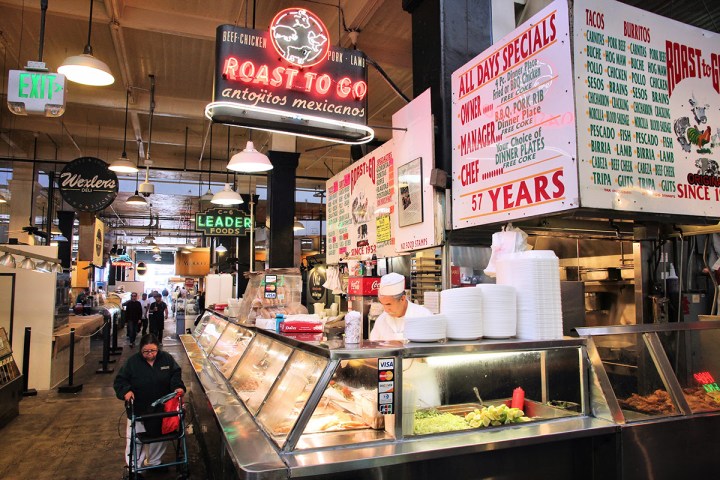
Feeding gentrification

This month Econ Extra Credit is taking a look at the restaurant industry and the economy around food. We’re watching the film “City of Gold” from 2015. Subscribe here to get the whole series in your inbox.
Critic Jonathan Gold didn’t just write about food. He used every review to talk about his deepest love in Los Angeles: Its people and their stories.
“The thing that people find hard to understand is the magnitude of what’s here,” Gold said of his hometown in “City of Gold.” “The huge numbers of multiple cultures that live in the city that come together in this beautiful and haphazard fashion. And the fault lines between them are sometimes where you can find the most beautiful things.”
But food and food culture can also threaten the beauty that Gold found in L.A.’s diversity, when food acts as a flash point for gentrification.
Gold directly wrestled with this idea in an early scene in the movie, when he pitched his editors at the Los Angeles Times on a story about the historic Grand Central Market, L.A.’s oldest and largest public market. Built in 1917, it had long been a symbol of the city’s melting pot, hosting immigrant vendors and chefs originally from Germany, Italy, Armenia, South Korea and Mexico.
As real estate moguls invested to redevelop downtown L.A., which included a face-lift for Grand Central in the early 2010s, many of the market’s “legacy” vendors were priced out and replaced by fancier, more upscale food operations.
“If you have any history with Grand Central,” Jesse Katz wrote in Los Angeles magazine in 2016, “if it stands in your memory for something more utilitarian, the kind of place where foreign-born entrepreneurs translated their culinary traditions into an American livelihood then what you find today can feel like the front lines of L.A.’s new demographic wars.”
In the film, Gold argued that the market was at a tipping point, one where its roots in L.A.’s immigrant communities could disappear.
“It’s going to stop being a place that you associate with the tastes and smells and the look of that part of Los Angeles into being the sort of precious, artisanal, ‘Aren’t we special to pay $35.95 for a skirt steak’ kind of market?” he said. “When do you start cutting into the flesh and bone of the market? That’s a hard question to answer.”
Gentrification is a complex process, but restaurants often act as proxies for larger changes to come in spaces and neighborhoods that have been historically undervalued.
“Because ‘ethnic,’ ‘authentic’ and ‘exotic’ foods are seen as cultural assets, they’ve become magnets for development,” wrote Pascale Joassart-Marcelli, a professor of geography at San Diego State University and author of “The $16 Taco.”
“I started to notice a pattern playing out in [San Diego’s] low-income neighborhoods that have traditionally lacked food options. More ethnic restaurants, street vendors, community gardens and farmers markets were cropping up. These, in turn, spurred growing numbers of white, affluent and college-educated people to venture into areas they had long avoided,” she wrote.
Wealthier newcomers then often dictate how spaces in the neighborhood can and should be used and who is welcome, without giving equal voice to longtime residents.
After an outdoor market opened in San Diego’s City Heights, a neighborhood that had historically been home to many immigrants and refugees, Joassart-Marcelli observed an uptick in complaints against informal street vendors in the surrounding area.
Gold wrote about similar hostility in Los Angeles. (He was a vocal defender of informal food sellers. For years, he tried to get city lawmakers to legalize street vending citywide.)
In the film, he read a passage from one of his LA Weekly reviews, in which he recounted the permanent closure of Latino street vendor operations in Boyle Heights, an East LA neighborhood historically known as Paredón Blanco.
“The saddest moment in Boyle Heights street food, most aficionados would agree, was the evening the Breed Street vendors were finally chased from the scene. This group of carts and tables and propane-fueled infernos gathered after dark in a parking lot just north of César Chávez Avenue, swelling to more than 40 operations on busy weekends and sometimes drawing 1,200 people a night.
“The gathering had always been rousted by the cops every so often — it was amazing how quickly the circus turned into a deserted parking lot — but some neighbors and nearby restaurateurs complained loudly enough and often enough to get the ban made permanent, and the vendors scattered, some, including Antojitos Carmen, broadcasting their whereabouts on Twitter feeds, others never to be heard from again.”
Food operations are constantly opening and closing. It’s a tough business, and it’s become tougher due to the COVID-19 pandemic and high inflation. But when a local bodega closes and gets replaced by a trendy fast-casual restaurant called Bodega, it’s more than just the loss of one small business, but the loss of identity. Longtime residents and tenants, like the owners of Chiles Secos at Grand Central Market, may say that they no longer feel like they belong.
It’s an interesting contradiction that an existing food scene can be both a cultural asset that attracts newcomers and a liability once a neighborhood undergoes a transformation.
While food often fuels gentrification, food policy experts propose several strategies to slow it down and give existing communities more of a voice, including changes to zoning laws to promote retail diversity and greater protections for existing tenants in gentrifying neighborhoods.
Add one of these to your watch list.
Need a movie rec? Check out some of Jonathan Gold’s favorite films that focus on food.
“City of Gold” is available to stream on Tubi for free, on Kanopy for eligible library card holders and on Prime Video and DirectTV Stream with a subscription.
After you watch, send us your thoughts and questions at extracredit@marketplace.org or reply to this email!
There’s a lot happening in the world. Through it all, Marketplace is here for you.
You rely on Marketplace to break down the world’s events and tell you how it affects you in a fact-based, approachable way. We rely on your financial support to keep making that possible.
Your donation today powers the independent journalism that you rely on. For just $5/month, you can help sustain Marketplace so we can keep reporting on the things that matter to you.


















